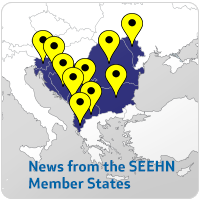Session 3: Relevance of various air pollution sources in driving health impacts.
Press Release
On June 8-9, the South-Eastern Europe Health Network participated at the virtual workshop on Air Pollution and Health in Southeast Europe.This event was organized by the Health Effects Institute (HEI), in cooperation with the International Society for Environmental Epidemiology (ISEE), and the European Respiratory Society (ERS), the Medical University of Plovdiv, Bulgaria, and environmental health institutions in Serbia.
The goal of the workshop was to review the status of current evidence on the health effects of air pollution in the Southeast European region and its interlinkage to current policy debate and actions.
As fine particulate matter (PM2.5) levels in Southeast Europe have remained higher than those in Western Europe for decades, public and governmental interest in the topic increases, and the demand for data and evidence on air pollution levels and trends, as well as health effects, is growing.
The workshop is part of the larger HEI project in Southeast Europe funded by the Clean Air Fund.
The director of the SEEHN Secretariat co-chaired the third session with Dr Angel Dzambov. The session 3 focused on the Relevance of various air pollution sources in driving health impacts.
In her welcoming address, Dr. Dasic showcased the devastating effects of air pollution. She stated that PM2 can lead to a wide range of diseases (e.g. Cardiovascular diseases and reduced lung function, respiratory infections, aggravated asthma etc). The World Health Organization provides evidence of links between exposure to air pollution and type 2 diabetes, obesity, systemic inflammation, Alzheimer’s disease, and dementia. The International Agency for Research on Cancer has classified air pollution, in particular PM2.5, as a leading cause of cancer. A recent global review found that chronic exposure can affect every organ in the body, complicating and exacerbating existing health conditions. Over 400,000 premature deaths (in 2018) are accounted for air pollution in Europe only.
The SEEHN director also emphasized the need to join forces to concentrate the efforts across countries, regions, and continents to improve the air quality across the globe.
Dr. Branislava I. Matić, Institute of Public Health of Serbia and Dr. Dima Tsanova, Medical University – Pleven, Bulgaria addressed the different sources that contribute to population exposure to key air pollutants in the region. Dr. Hanna Boogaard, HEI, ISEE-Europe underlined the benefits of air pollution interventions.In the concluding remarks of the sessions, Dr. Dasic highlighted that air pollution is a major cause of premature death and disease, and is the single largest environmental health risk in Europe and that we need to join forces to accelerate equitable and sustainable interventions.






